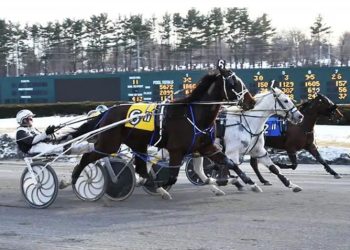The recent call for nominations to the Harness Racing New Zealand Board of Directors has come and gone without much fanfare with three nominees put forth for two incumbent positions left by the three-year rotation policy in place.
Current finance chair, Colin Hair, has chosen not to seek re-election after well over a decade of governance at the highest level.
HRNZ Chairman of the Board, John Coulam, seeks another term as a result of the three-year-policy.
Two further nominations has resulted in an election being called with Doug Gale (Kapiti) and Cam Bray (Banks Peninsula) joining Coulam as candidates seeking election by the clubs.
Cam Bray’s nomination may come as a surprise to some given he is better known in Harness Racing circles for his auctioneering prowess as the man behind the rostrum at our national standardbred sales in his capacity as Standardbred Manager of New Zealand Bloodstock.

What flies under the radar however is the volume of work he does behind the scenes as an administrator of the sport.
Bray is the President of the Banks Peninsula Trotting club, a position he has held for two years having worked his way through the committee channels to assume the role.
He also sits on the NZ Sires Stakes Board as an appointee of the bloodstock agent, New Zealand Bloodstock Standardbred.
His administration experience extends further having also been selected as a volunteer last year to work as part of the HRNZ ‘architect group’ overseeing changes to the New Zealand racing calendar in an effort to revitalize the sport.
At just 34 years old, Bray has been able to garner a holistic view of the industry and an intimate understanding of the challenges that are before the industry.
Speaking with Bray this morning it is obvious he acutely aware of the challenges which have only motivated him to broaden his commitment to the sport and attempt to influence change at an even deeper level.
“When you look at change and how things happen, having an understanding of how the various wheels of the sport turn is important and isn’t as easy as most people think,” said Bray.
“It’s easy to go into positions of administration with massive ideas of change, but the reality is that Rome wasn’t built in a day. In my dealings with HRNZ and their management it’s obvious they understand that change needs to happen, but it’s about providing change in areas that are going to benefit the sport to be its best.”
When confronted as to what immediate challenges that need addressing, Bray was quick to point to two main areas of concern.
“The obvious one is breeding and our foal population. But any impact we are to realise through breeding initiatives won’t be felt for at least four to five years and will take time. That’s why it is important that we don’t lose sight of the fact that as an industry we need to get our programming
right and have better utilization of our current racing population, not just for the clubs in our own backyard, but for everyone. If we work together, we all stand to benefit rather than just using the tribalist approach.”
“Through my various roles I end up living a lot of the challenges the industry faces. Obviously, we are leaking a lot of horses to Australia and a lot of it does come back to programming. The people I talk to don’t necessarily want more stake money, they just want more ability to get a bite of the race stakes on offer a bit more often and that can be achieved if we get a bit more creative with the racing product.”
“Breeding is a huge part of what I do professionally, so it’s always been a focus of mine, but people need to understand that the provision of horse we are losing is not the sales horse. I’m not here to try and influence more horses going through the sales ring. Ultimately, I want to try and facilitate an environment that encourages more breeders racing their stock and the bread-and-butter horses that generate turnover. We need to get the owner breeder back and re-engaged with this sport and make them believe that there is an opportunity to put a mare in foal and get a bit of reward.”
Two-way communication between an industry and its stakeholders is a challenging environment for any industry in an era where consultation and transparency are imperative. For anyone questioning that sentiment look no further then the situation unfolding around New Zealand Rugby and its recent series loss to Ireland.
One of the criticisms of harness racing industry participants is the inability to get cut through at the highest level and Bray believes this is an area of particular importance for the directors.
“Rightly or wrongly one of the things I see as an opportunity for the board is greater visibility at the ground level. It’s what the participants of the sport need and want. They want to be able to see and talk to someone who they believe has a bit of influence and feel like their voice is heard,” he said.
“It might result in a bit of an ear bashing from time to time but that’s all part of it. It happens in my professionally capacity and the stakeholders just want to get things off their chest from time to time and its what ultimately helps the sport prosper is having those communication lines open.”
by Brad Reid, for Harnesslink

 USA
USA Canada
Canada Australia
Australia New Zealand
New Zealand Europe
Europe UK / IRE
UK / IRE



